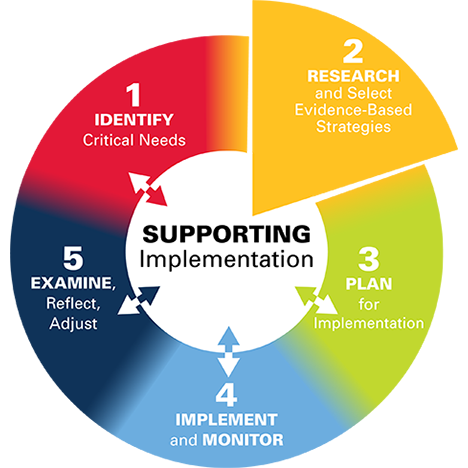Research and Select Evidence-Based Strategies
After identifying critical needs and root causes, teams research and select an evidence-based strategy that addresses the prioritized, critical needs. Benefits of selecting an evidence-based strategy include:
- Greater likelihood of positive student outcomes if the strategy is implemented as outlined in the research; and
- Assurance that time and resources will go toward strategies that show evidence of achieving positive student outcomes.

The district leadership team (DLT), building leadership team (BLT) and teacher-based teams (TBTs) all play crucial roles in researching and selecting evidence-based strategies.
DLT - Researches and selects, or continues using, evidence-based, district-level strategies that increase student achievement while minimizing the achievement gaps between student groups.
BLT - Researches and selects, or continues using, evidence-based, building-wide strategies that align with district strategies, increase student achievement and address students’ critical needs while minimizing the achievement gaps.
TBTs - Research and select evidence-based instructional practices that align with selected district and building strategies and, when fully implemented:
- Increase student achievement;
- Align to the needs of learners; and
- Close achievement gaps.
Using a Research Clearinghouse
A clearinghouse is a collection of researched practices that have been evaluated for their intended impact. Each clearinghouse has its own policies for including and rating practices, so teams must determine the level of evidence associated with a chosen strategy. As a team selects an evidence-based strategy, that strategy should align to the building or district context.
Ohio's Evidence-Based Clearinghouse is:
- Practitioner focused:
- Administrators and educators are the primary audience;
- Integrated with the Ohio Improvement Process;
- Dynamic, with growing resources; and
- Connected to Ohio’s peer-to-peer networks.
Levels of Evidence
Section 8002 of ESSA defined four levels of evidence:
- Level 1 - Strong evidence from at least one well-designed, well-implemented experimental study.
- Level 2 - Moderate evidence from at least one well-designed, well-implemented, quasi-experimental study. A strategy can be Level 1 or Level 2 for district or school use only if the research shows the intervention improves student outcomes for the student subgroup the district or school intends to support.
- Level 3 - Promising evidence from at least one well-designed, well-implemented correlational study.
- Level 4 - Yields high-quality research findings or evaluations that do not meet Levels 1 through 3 criteria but suggest that the activity, strategy or intervention is likely to improve outcomes. When an organization chooses a Level 4 evidence-based strategy, it commits to evaluating that strategy to determine whether it is working.
Evidence-Based Strategies
Evidence-based strategies are programs, practices or activities that have been proven to improve student outcomes. Districts can be confident these strategies are likely to produce positive results when implemented as intended.
For a practice to be "evidence based," an external evaluator must have evaluated its effectiveness. The design and outcome of the evaluation will determine what, if any, level of evidence the intervention meets.
When selecting an evidence-based strategy, team members must be aware of its core components, required time commitment, funding and expectations for full implementation. This helps teams select the most appropriate strategy to address the critical needs identified in Step 1 - Identify Critical Needs.
Strategy Review
Consider these factors when selecting evidence-based strategies:
- Alignment to district and school goals and strategies;
- Implementation time;
- Implementation resources needed, including funding;
- Sustainability;
- Amount of professional learning teachers and administrators need to fully implement the strategy;
- District or school need and priority;
- Fit with current initiatives;
- Level of evidence; and
- District or school capacity to implement
Teams should inventory current strategies and their effectiveness when addressing critical needs. Selecting a new, evidence-based strategy might require ending a current practice.
